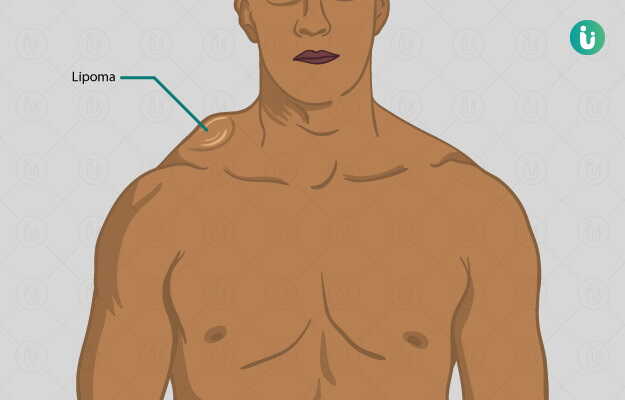Lipoma removal surgery is a minor surgical procedure that is employed to remove lipomas. The surgery is usually done when the lipoma becomes symptomatic or causes cosmetic discomfort. Investigations involve routine blood investigations and radiological investigations of the lipoma.
The surgery is of short duration with limited risks and hence is usually a day-care procedure. Postoperative care and management are usually uneventful with a low chance of recurrence
- What is Lipoma removal surgery
- Indications for surgery
- Contraindications of surgery
- Preparations before surgery
- What happens during the surgery
- Risks and complications of the surgery
- Aftercare, discharge and follow up
- Takeaway
What is Lipoma removal surgery
A lipoma is a soft, painless, mobile swelling (lump) under the skin which is composed of fat. they are benign (non-cancerous) swellings. Lipomas are quite common in individuals and have a genetic predisposition. They can be found anywhere on the body but are commonly seen on the back, torso, arms, shoulder and neck. They are usually asymptomatic and other than cosmetic reasons do not need to be managed.
The surgical procedure to remove the swelling is known as lipoma removal surgery. The surgery is a simple minor procedure with a high success rate and minimal complications.
The surgery is performed by using either of the two methods
- Excision: these are done in relatively smaller lipomas.
- Liposuction: the approach is used in relatively large lipomas
Indications for surgery
Lipomas usually are asymptomatic and are advised to be left alone. Surgery is advised when the swelling becomes symptomatic. The symptoms may include:
- A sudden increase in the size of the lump
- Redness, tenderness or pain in the lump
- The consistency of the lump changes, i.e. it becomes firm or hard as opposed to its natural soft consistency
- Pain due to the lump pressing on any nerve
- Bruising over the swelling, which occurs if there are blood vessels in the lipoma (angiolipoma)
- Cosmetic distress
- Suspected or confirmed diagnosis of the swelling as malignant (cancerous)
Contraindications of surgery
Lipoma removal surgery is relatively risk-free and hence there are no specific contraindications for the surgery. However, in patients with pre-existing conditions who require regional anaesthesia (a part of the body is made numb) or general anaesthesia, the risks associated with anaesthesia increase and hence these conditions are to be controlled before surgery
Preparations before surgery
The surgery is performed by a general surgeon. The surgeon takes a detailed history of the patient which include the symptoms of the patient, family history (genetic predisposition or genetic disorders are a contributing factor to developing lipomas) and medication history.
Medications, if any, for any pre-existing conditions may be altered/stopped as per the surgeon's orders before surgery.
Investigations before surgery include:
- Routine blood tests
- Chest X-ray
- ECG
- To differentiate between a lipoma and cyst (fluid-filled swelling) radiological investigations such as ultrasound, CT or MRI scan of the swelling are done. These investigations also help determine the content of the swelling (such as blood vessels) as well as the surrounding structures that the swelling may be compressing (such as nerves).
- A biopsy (sample of tissue) may be taken in large lipomas and sent for pathological investigation to rule out malignancy
The surgery is done via day-care admission. Prior to the day of the surgery, the patient is told to be kept fasting overnight.
On the day of surgery, the patient arrives at the hospital with all the relevant investigations and reports and gets admitted. The patient changes into the hospital attire and a final review of the patient is done by the surgeon and nurses before he is cleared for surgery.
Written consent is taken from the patient after the surgeon explains the technique of the procedure along with the risks and outcome. The area of the surgery is shaved (part preparation) after which the patient is shifted to the minor operation theatre (OT).
What happens during the surgery
Depending on the location of the lipoma the patient will place either supine (lying on the back) or prone (lying on the stomach) on the operating table. A monitor is attached to keep track of the patient’s vitals (heart rate, blood pressure and oxygen saturation).
An IV cannula is inserted to administer medications for the procedure. The area of surgery is cleaned and covered with sterile drapes. Depending on the location and size of the lipoma, local/regional/general anaesthesia may be given.
There are two approaches to lipoma removal. They are:
- Excision of the lipoma: this method is used when the lipoma is relatively small and easily accessible. An incision is made using a scalpel (sharp sterile blade) and the lipoma is squeezed out by detaching (excising) from the surrounding tissue.
- Liposuction: this is a newer method used for large/ multiple lipomas. An incision is made after which a thin hollow tube is inserted which sucks out all the fat. The advantage of the method is that it requires a smaller incision. However, it is relatively costlier.
After the removal of the lipoma, pressure is applied to stop any bleeding. The wound is later sutured (stitched) using absorbable sutures and a bandage is applied over it. These sutures dissolve after a specific duration of time. The lipoma is sent for pathological investigations post-surgery.
The surgery is of short duration i.e. between 30 minutes to one hour.
Risks and complications of the surgery
Risks and complications are minimal. However, some of the risks include
Aftercare, discharge and follow up
After the procedure, the patient is shifted from the OT and kept under observation for a few hours. Pain at the site of surgery is managed with analgesics.
A discharge summary is prepared by the doctor which includes relevant medications and advice on wound care. These typically include:
- Continuation of medication for pre-existing conditions, if any
- Antibiotics and analgesics to prevent infection and pain respectively
- The bandage is to be removed after 12-24hrs. Swelling and minor bleeding of the wound can be controlled by applying ice packs.
- Maintenance of hygiene of the wound site is advised to prevent infection
- Avoidance of applying creams/powders/oils is to be followed until the sutures dissolve on their own
- After bathing the area is to be patted dry.
- Avoid any strenuous activities or exercises for a couple of days to prevent pulling and tearing of the stitches that can reopen the wound.
The doctor should be notified if any of the following symptoms are seen
The entire wound takes one to two weeks to heal. The sutures dissolve by themselves over time and may or may not leave a scar depending on the technique of wound closure.
Follow up is as per the instructions of the doctor and to discuss the results of the pathological investigation of the lipoma.
Takeaway
In conclusion, lipoma removal surgery is required in lipomas that have become symptomatic or are causing cosmetic discomfort. The surgery is short with a high success rate and minimal complications. Recurrence of a lipoma post-surgery is rare.















